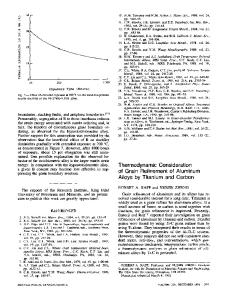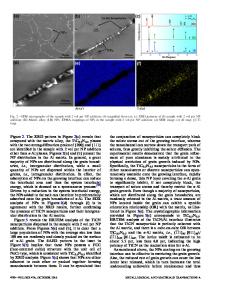Grain refinement in magnetically stirred GTA welds of aluminum alloys
- PDF / 3,450,065 Bytes
- 8 Pages / 603.28 x 783.28 pts Page_size
- 54 Downloads / 323 Views
FINEequiaxed grain
structures in welds have better resistance to hot cracking. The development of grain refinement procedures is therefore an important topic in current welding research. The grain structure of normal gas-tungsten arc (GTA) welds depends on both welding conditions and alloy content. ~,2 Recently it has been shown that transitions to more refined structures in GTA welds of aluminum alloys are caused mainly by Ti a n d / o r Zr providing heterogeneous nuclei. 3 This is consistent with the well-known effects of Ti 4-12 and Zr 7 on grain refinement in Al-base castings. The influence of alternating external magnetic fields on grain structures in welds has been investigated by both Matsuda and co-workers ~3,~4and Chernysh and Pakhareako. 15 Under certain conditions, extensive grain refinement was found in some alloys, while in other alloys alternating external magnetic fields had little or no effect on grain refinement. Until now, the mechanism of grain refinement in welds due to the external magnetic field has not been determined. The application of an external magnetic field parallel to the welding electrode results in rapid circular motion of the welding arc. 16 This arc rotation causes rotary fluid motion within the weld pool. ~3 If the polarity of the magnetic field is reversed, the direction of the arc's motion reverses, thus changing the direction of fluid motion. In ingots, crystal multiplication is caused by fluid flow remelting or breaking off dendrite tips, which nucleate new crystals. Dendrite tip detachment was therefore suggested as a possible mechanism of grain refinement by magnetic fields in welds. However, fluid motion penetration into the dendrite network of a GTA weld would be more difficult than in ingots, due to the finer spacing between dendrites in a weld. 2 This finer dendrite spacing, and the presence of the heat source, makes the B. P. PEARCE and H. W. KERR are Research Assistant and Professor, respectively,Department of Mechanical Engineering, University of Waterloo, Waterloo, Ontario, Canada. Manuscript submitted November 3, 1980.
survival of dendrite bits more unlikely in welds. Moreover, the work by Matsuda et a113,t4 clearly showed that increasing the amount of titanium in otherwise similar alloys strongly increased the degree of grain refinement which could be achieved by applying external magnetic fields. This suggested that heterogeneous nucleation also may be responsible for grain refinement in magnetically stirred welds. An investigation of possible grain refinement mechanisms in magnetically stirred GTA welds was undertaken to clarify the situation. By identifying the nucleation mechanism(s), refinement of " h a r d to refine" alloys may be made possible. EXPERIMENTAL PROCEDURES All welds were produced using the gas tungsten arc (GTA) process. Direct current was used with the electrode positive. A 4.5 mm diam tungsten - 2 pct thoriated electrode having a hemispherical tip was used, with argon as the shielding gas flowing at 0.85 m3/h. The electrode was vertical with
Data Loading...











